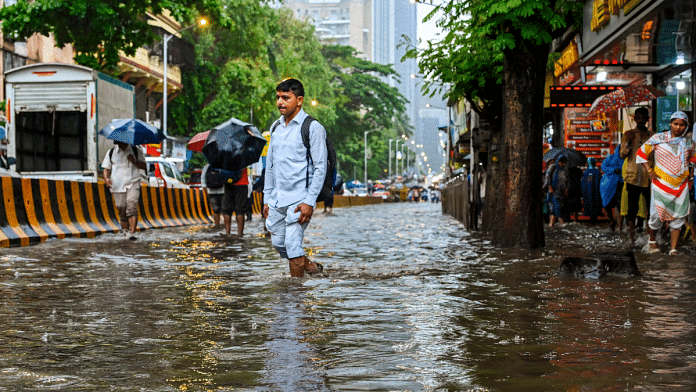New Delhi: When it comes to climate action plans, there’s no one-size-fits-all solution. What works for Mumbai will not apply to Bengaluru. A good plan begins with data.
“The framework for climate action plans isn’t just about the quantity of data; it is about the quality. And it was about access to data,” said Jaya Dhindaw, Executive Program Director (Sustainable Cities), at World Resources Institute (WRI) India. At an online seminar conducted by the Centre de Sciences Humaines and Centre for Policy Research last month, she compared the climate action plans of four cities—Mumbai, Bengaluru, Nashik, and Patan.
Cities are shaped by their scale, institutional readiness, quality of datasets, and political economy. Dhindaw showed how large cities like Mumbai benefit from a strong political mandate. On the other hand, smaller cities like Nashik, lacking Mumbai’s resources—and population—operate in “adaptive and locally embedded contexts”.
Mumbai was the first city to come up with a comprehensive plan in 2022, and the WRI had a role to play in it. When Mumbai became a ‘C-40 city‘, the state government reached out to them for help. Initially, they were given three months to build a framework of the climate action plan, but that, said Dhindaw, is not enough time.
The whole process of urban planning is related to the devolution of power. “Over two decades of my own work in the field of urban planning, we know how difficult it has been to garner political commitment to plans,” said Champaka Rajagopal, a senior researcher at the Centre for Policy Research who facilitated the online session.
Four urban realities
Mumbai’s municipal corporation budget is upwards of Rs 70,000 crore, but the city still struggles when it comes to implementing climate action plans. Drainage and solid waste management were not yielding significant results on the ground.
Mumbai was spending a lot on its urban greening initiatives—but without considering local ecosystems or using scientific methods, remarked Dhindaw. “Every time the city flooded, the saplings that we had planted or whatever you had done would come undone. And that was a waste of effort, money, everything,” said Dhindaw.
For all the hurdles, action plans for Mumbai got people thinking about climate and urban planning. Radio Mirchi came on board with the Brihanmumbai Municipal Corporation (BMC) and called on “Mumbai’s green yodhas (warriors)” to plant trees. WRI and BMC then came up with a Greening Handbook in December 2023, guiding citizens on greening initiatives from balcony gardens to larger spaces.
After Mumbai, climate action plans followed for Bengaluru in 2022, recalled Dhindaw. The IT hub is growing, but mostly on the periphery. Dhindaw’s team found in one of its assessments that around 85 per cent of the floodplains in Bengaluru have been encroached upon, and groundwater is extremely exploited. Built-up areas prevent water from finding its way back to the ground, limiting Bengaluru’s groundwater recharge potential.
“So, you have 100 mm of rain over a couple of hours, and the city and parts of the city are inundated”, said Dhindaw.
Traffic congestion isn’t Bengaluru’s only problem. It’s also becoming an island of heat, stressed Dhindaw. The growing number of buildings and vanishing parks are increasing the city’s heat stress. “This is actually becoming a big problem, especially in the peripheries” said Dhindaw.
Bengaluru sees high citizen participation in climate action plans. “People want to engage with climate action,” said Dhindaw. And programmes like the ‘Friends of Climate Action Cell’ help facilitate this. “One can go find ideas, partners, collaborators, and work with them towards certain issues, whether it’s lake rejuvenation or anything else,” Dhindaw added.
Unlike Mumbai and Bengaluru, Nashik is a mid-sized city surrounded by vineyards. But its location in the industrial belt of Maharashtra exposes the city to high risks of air pollution. Nashik, therefore, signed the “Race to Zero” pledge to achieve net-zero emissions by 2040. Before that, it has plans to host the next Kumbh in 2027. The climate action plans for Nashik aim to prioritise air quality, heat, and flooding.
In Gujarat’s Patan, the Solanki dynasty built sophisticated water conservation structures such as Rani ki Vav and Sahastralinga Talab. Today, the historical city is severely water-stressed. “WRI is working as a consultant with Tata Trusts to find solutions,” said Dhindaw.
Also read:
Who feels the heat more?
Mumbai and Bengaluru’s growth has been largely peripheral. Mumbai, for instance, has a high percentage of people living in slums and informal settlements. According to a study conducted by Dhindaw and her team, the city exhibits “differential vulnerabilities”. “The way Amitabh Bachchan experiences flooding is very different from the way the community right outside his home experiences it,” said Dhindaw.
Meanwhile, in Bengaluru, migrant labourers coming from ‘climate risk’ areas end up living in the city’s low-lying areas, which are prone to flooding, said Dhindaw.
In Patan, slum communities and their neighbourhoods experience ‘differential temperatures’. Dhindaw and her team’s assessment reveals that there were noticeable temperature differences just 100 to 200 meters away from slum areas in the city.
Collating data across fragmented governance structures is a huge challenge—even in big cities like Mumbai and Bengaluru.
To come up with their own climate vulnerability assessment framework, Dhindaw and her team used the City Inventory Reporting and Information System (CIRIS), developed by C-40 cities to manage greenhouse gas emissions’ inventory data. They also made use of the World Bank’s Climate Action for Urban Sustainability (CURB) tool, which draws on “local city data to provide tailored analyses that will help cities evaluate low carbon actions.” India needs its own reliable data systems, Dhindaw stressed. “Global tools may not be a perfect fit for our own unique local context. In the absence of reliable data, there is a risk of cities running amok with CAPs devoid of any scientific reality,” Dhindaw said.
(Edited by Zoya Bhatti)






